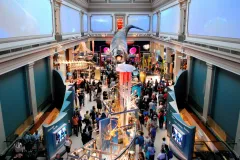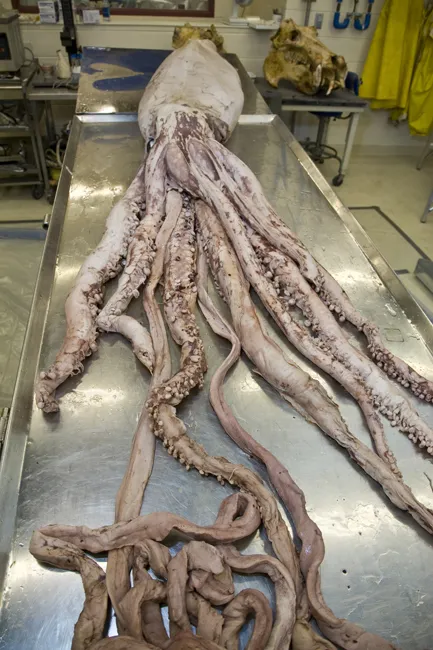The Sant Ocean Hall Turns Ten

The ocean is essential to all life, and covers 71 percent of the Earth’s surface. So how do you fit it in a mere 23,000-square-foot space?
That was the task facing curators, exhibit designers, and educators ten years ago at the National Museum of Natural History as they brought the Sant Ocean Hall together. Named after Victoria, and Roger Sant, and family who donated 15 million dollars for an ocean initiative, the hall took 5 years to complete and involved colleagues from the museum, the National Oceanic and Atmospheric Administration, the Fish and Wildlife Service, along with other companies and nonprofit organizations.
The exhibit team decided to take advantage of the Museum’s collections to share stories and inspire interest in the ocean. There are over 600 specimens and models in the hall, and even a 1,500-gallon Indo-Pacific coral reef tank with a variety of fish species swimming among live anemones. From large (Phoenix, the 45-foot-long life-sized model of a North Atlantic right whale) to small (a jar full of preserved Antarctic krill specimens) the Ocean Hall explores ocean ecosystems past and present.
Tucked away in one corner lies a coelacanth, a fish once thought to be extinct. For Jennifer Collins, manager of ocean education at the museum, it was this very fish that inspired her to begin a career in ocean science. “The first time I saw our coelacanth, I got all teary-eyed,” Collins says. Karen Osborn, a curator of invertebrates at the museum, also has a soft spot for this specimen, “The Coelacanth is possibly one of my favorites as far as being impressive because it shows how many mysteries remain in the oceans.”
A giant squid sits in a massive tank in the center of the hall, though getting it there required a bit of creative thinking. It’s not every day that a giant squid the length of a school bus is shipped across the Atlantic, from Spain to Washington, D.C. “That was my last big problem, and I just kept putting it off,” says Elizabeth Musteen, project manager for the exhibit. Without many options, a joke happened to inspire a solution. The Museum was able to work with the Navy, who regularly ship large and heavy containers across the globe, to successfully transport the 300-pound squid to the Museum via “Operation Calamari.”
Understanding that humans, too, have a role in the ocean world, the exhibit's designers made a concerted effort to weave in stories and artifacts that represent this relationship. Above an archway at the back of the hall is a 25-foot, intricately carved canoe handmade by a Tlingit master carver. Called the Raven Spirit canoe, it embodies how an ocean creature, the salmon, has a profound impact on humanity. An abundance of salmon enabled Native tribes of the Northwest to develop complex societies and unique cultures. But overfishing and development depleted much of the salmon population, a lesson and just one of several stories in the hall that conveys how humans can impact life at sea.
“The ocean is such an important place and a driver of how the planet functions which is something that people don’t realize, so it’s a really important space for helping visitors connect to that,” says Collins.
Beyond specimens and science, the hall showcases the ocean as a source of creative inspiration. Tucked in the back of the hall, the Ocean Focus Gallery has hosted six temporary exhibits. In 2011, giant bioluminescent sculptures hung from the ceiling in the gallery and flashed in a syncopated rhythm. At one point, a massive, 10-by-16-foot yarn reef filled the gallery with expertly crocheted corals and sponges from the community. The seventh exhibit in the space opens this November and will feature a mosasaur—the large reptilian predator that roamed the seas millions of years ago.
Regardless of whether you are a paleo buff intrigued by the ancient seas, a conservationist concerned about the ocean’s future, or an artist inspired by the beauty of ocean life, there is something for everyone at the Sant Ocean Hall. And for some, like Michael Vecchione, a curator with invertebrate zoology involved in designing the exhibit, picking a favorite is too difficult. He sums it up, “I am proud of the entire exhibit and whenever I am there, my favorite is whatever I happen to be standing near.”


